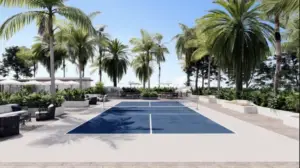Serving in pickleball is quite literally where the game starts. If you can’t follow (or don’t know) the rules for serving in pickleball, well then you won’t be able to land a legal serve or play much at all.
Learning how to consistently hit a legal serve can feel overwhelming, let alone getting good enough to hit serves that are hard to return. But with a little bit of knowledge and a lot of practice, it’s a totally achievable thing (and necessary step) for players of all levels.
Pickleball Serving Rules
Pickleball serving rules: What you need to know
There are three requirements for how to hit a legal pickleball serve. It must be hit underhand from behind the baseline, clear the net, and land in the service court of your opponent opposite to where the server stand.
When you break it down, a legal serve has four parts:
- Where you serve it from
- The style in which you hit it.
- The way it travels through the air.
- Where it lands on the opposite side of the net.

If it seems a little vague, don’t worry — we’ll dive into each part.
Rules for serve positioning in pickleball
To start let’s talk about where you should stand when you serve. It’s actually pretty simple — the server must stand behind the baseline and on the right or left side of the center line. At least one foot must remain in contact with the ground behind the baseline. The other foot may come off the ground, but it cannot land in the court of play (including touching the baseline) until the ball is struck.
If you’re unfamiliar with the court dimensions or terminology, it might be a good idea to review these before you get started.
In double’s each player will have a turn to serve, unless it is the game’s opening serve. The official rules from USA Pickleball say the player on the right side (even court) serves first. If a point is scored, then you move over to left side and serve again.
If playing singles, the rules are slightly different. Everything is the same, but the side of the court changes depending on how many points you have. The right side of the court is known as the even side, so when you have an even amount of points, you serve from there. The left side is the odd side and when you have an odd amount of points, you serve from there.
Striking the ball
Let’s get into the serve itself. When striking the ball, the serve has to be hit underhand and clear the net without touching it on the way over.
There are a few other specific pickleball serving rules you’ll want to keep in mind:
- The ball must be struck with an open paddle face, meaning the paddle is not perpendicular to the ball
- The ball must be struck in an upward motion (so underhand serves only)
- The ball must not bounce on your side of the court before crossing the net
Traveling through the air and landing
After you strike the ball, the rest is pretty simple. To remain a legal serve, the ball must:
- Travel through the air to your opponents side of the net without touching the net
- Land in the service court opposite to where you served of within the court of play
Remember that if the ball strikes any part of the white line, it’s in play! Once you master your shot, a smart tactic can be to place the ball on the line. This will maximize the distance your opponent has to move to return the ball. They might also misread is as a shot going out of bounds and not bother trying to return it which can land you the ever-elusive ace serve!
Illegal pickleball serves
No matter how good you are, there are going to don’t follow all of the pickleball serving rules (or fault as we picklers call it) on your serve. When this happens, don’t worry! If you serve the ball and it doesn’t meet the requirements:
- In doubles, the ball will go to your partner if you were the first to serve or to your opponent if you were the second
- In singles, it will go your opponent and they will be awarded a point

Pickleball serving techniques
There are a few different types of serves you can use in pickleball, each with its own set of rules. Here’s a rundown of the most common serves:
The lob serve
This serve is hit high and deep into the opponent’s court and is great for beginners working on keeping their serve in play. Strike the with an underhand motion and must bounce once on the receiving team’s side of the court before they can hit it back.
The drive serve
This serve is hit with a lot of power and is often used to put pressure on the receiving team. To nail a drive serve, hit the ball hard and keep it as close to the net as possible without touching it. You’ll want to angle it towards the side boundary to increse the difficulty of returning it.
The dink serve
This serve is hit with less power and is often used to set up a shot for the serving team. Strike the ball softly and attempt to land it just on the other side of the non-volley line to force your opponent to run up to return to the ball.

Spencer is writer and website owner from California. He started playing pickleball with his pops and they have a running tally of matches won and lost. Spencer declines comment on where the record stands.









3 thoughts on “Pickleball Serving Rules: How to Master Your First Hit”
Comments are closed.